
Dudleya abramsiisubsp. setchellii, known by common name as the Santa Clara Valley dudleya or Santa Clara Valley liveforever, is a member of the Dudleya genus of succulent perennials, members of the family Crassulaceae. The Santa Clara Valley dudleya, endemic to the Santa Clara Valley region in the southern San Francisco Bay Area, was listed on 3 February 1995, as an endangered species. It is considered to be a subspecies of Dudleya abramsii, but its taxonomic status is still unclear. Its closest relative is Dudleya cymosa subsp. paniculata, which is a morphologically similar sister taxon.

Dudleya caespitosa is a succulent plant known by several common names, including sea lettuce, sand lettuce, and coast dudleya. It is endemic to California, where it grows along the coastline in the southern half of the state. Taxonomically, this species is a highly variable complex of polymorphic and polyploid plants, closely related to numerous neighboring species such as Dudleya farinosa, Dudleya greenei and Dudleya palmeri. It is delimited from neighboring species on an arbitrary basis of distribution and chromosome number, and may not be immediately separable from the other species it approaches.

Dudleya abramsiisubsp.calcicola is a succulent plant known by the common name limestone liveforever, or limestone dudleya. It is endemic to California, where it is a rare resident of limestone outcroppings and rocky slopes in the southern Sierra Nevada and nearby mountains and foothills. It was formerly regarded as Dudleya calcicola.

Dudleya densiflora is a species of succulent plant in the family Crassulaceae known commonly as the San Gabriel Mountains liveforever or San Gabriel Mountains dudleya. A very rare plant confined to the San Gabriel Mountains of Los Angeles County, California, it is known only from three to five spots in the mountain range, with an estimated 1,700 individual plants remaining. Growing in the cracks of the granite slopes of three canyons in this single mountain range, it is threatened by human activity such as rock quarrying and off-trail recreation.

Dudleya lanceolata is a succulent plant known by the common name lanceleaf liveforever or lance-leaved dudleya. It is an extremely variable and widely ranging species that occurs from Monterey County and Kern County in California south through Ensenada in Baja California. It is characterized by green to purple lanceolate leaves, red, orange, or less commonly yellow petals, and is typically tetraploid. Despite its diversity, it is quite stable as a species, but hybrids may be discovered with other species of Dudleya, which can make it difficult to discern in areas where numerous species converge.
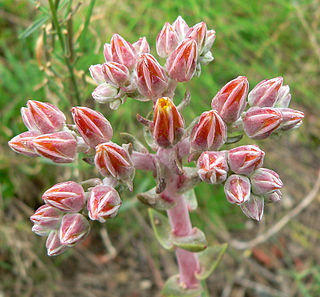
Dudleya palmeri is a species of succulent plant in the family Crassulaceae known by the common name Palmer's liveforever. This Dudleya is endemic to California where it grows along the coast. It is characterized by orange to red over yellow or pink flowers. It is a polyploid species that closely resembles Dudleya lanceolata but has a coastal habit, and hybridizes with Dudleya caespitosa and Dudleya cymosa.
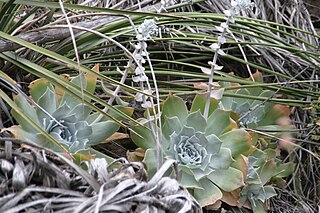
Dudleya pulverulenta is a species of perennial succulent plant known by the common names chalk lettuce, chalk dudleya, and chalk liveforever. It is one of the largest Dudleya, with a silvery, waxy rosette that may greatly contrast with its habitat. It is also regarded as one of the most distinctive members of the Dudleya, with one of the most specialized inflorescences in the genus, adapted to hummingbird pollination through its red pendent flowers, the longest corolla, and the highest nectar output. Dudleya pulverulenta has the largest range of all Dudleya, over 1,000 kilometres (620 mi), being found from southern Monterey County in California to the Sierra de San Borja in southern Baja California. It is closely related to Dudleya arizonica, a smaller desert species that tends to lack the specialized floral traits, and Dudleya anthonyi, which differs in a few morphological traits and is restricted to the San Quintín Volcanic Field.

Dudleya greenei is a perennial species of succulent plant known by the common names Greene's liveforever, or Greene's dudleya. It is endemic to the Channel Islands of California, where it grows along the cliffs of four of the eight islands. It is a highly variable plant, presenting with multiple forms and varying levels of ploidy. Taxonomically, this species is an insular segregate of Dudleya caespitosa, and was placed as a stopgap taxon by Reid Moran in his 1951 thesis on the genus. It is characterized by white or green leaf rosettes, loomed over by inflorescences bearing pale yellow to white flowers. It is a member of the subgenus Dudleya, as it cannot be propagated from leaf cuttings, does not grow from a corm, and has tight petals.
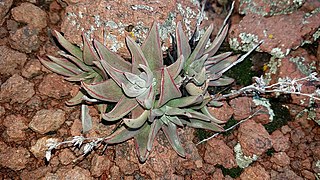
Dudleya abramsii is a species complex of succulent plants native to California and parts of Baja California. There are numerous subspecies, some critically endangered, with varying habits and lifestyles, but most often characterized by a smaller size, yellow flowers, and an affinity for rocky habitats. The subspecies may be polyphyletic.
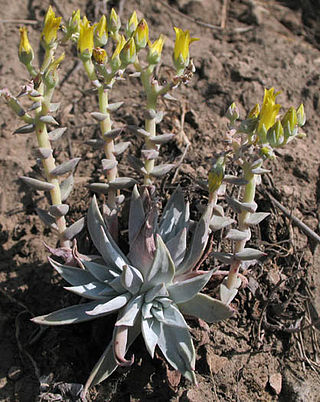
Dudleya verityi is a rare species of succulent plant known by the common name Verity's liveforever. It is endemic to Ventura County, California, where it is known from only three occurrences in the vicinity of Conejo Mountain between Camarillo and Thousand Oaks. It probably occurs in a few additional locations nearby which have not yet been officially vouchered.

Dudleya attenuata is a species of perennial succulent plant known by the common name taper-tip liveforever, native to Baja California and a small portion of California. A rosette-forming leaf succulent, it has narrow pencil shaped leaves that can often be found covered in a white epicuticular wax. The thin, sprawling stems branch to form the clusters of rosettes, with plants creating a "clump" up to 40 cm wide. The small flowers are white or yellow, with 5 spreading petals. It is a diverse, variable species that extends from the southernmost coast of San Diego County to an area slightly north of the Vizcaino Desert, hybridizing with many other species of Dudleya in its range. Some plants with white or pinkish flowers were referred to as Orcutt's liveforever, referring to a former subspecies split on the basis of the flower color.

Dudleya pauciflora is a species of succulent plant in the stonecrop family known by the common name few-flower liveforever. It is characterized by its small crowded rosettes of narrow leaves and its colorful inflorescence with red-yellow flowers. Found growing on rocky outcrops and cliffs in the high elevation mountains of the Sierra de San Pedro Martir and the Sierra de San Borja, it is endemic to the state of Baja California, Mexico.

Dudleya nubigena is a species of succulent plants in the family Crassulaceae. It is a rosette forming perennial with flattish leaves. Endemic to southern Baja California Sur, the species is found in the Sierra de la Laguna and the surrounding lowlands, a small southern portion of the Sierra de la Giganta, and on Isla Espíritu Santo, with a subspecies endemic to Cerralvo Island.

Dudleya abramsii subsp. abramsii is a species of succulent plant in the family Crassulaceae known by the common name as Abrams' liveforever. It is a small, delicate plant found growing among rocks, and is characterized by yellow flowers with a red tinge that emerge from May to July. It is native to the southern Sierra Nevada of California and the Peninsular Ranges across both the United States and Mexico.
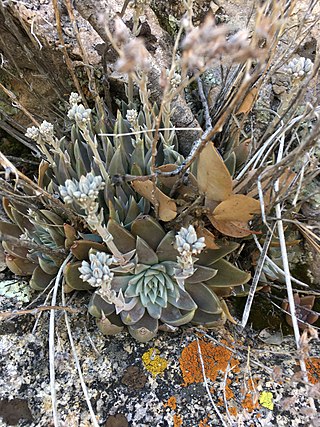
Dudleya abramsii subsp. affinis, commonly known as the San Bernardino Mountains Dudleya, is a subspecies of succulent plant endemic to a portion of the San Bernardino Mountains in California. It is a plant with an unbranching stem and elliptical leaves occurring in Green Canyon and the nearby plateaus.

Dudleya cymosa subsp. paniculata, known by the common name Diablo Range dudleya, is a species of perennial succulent plant in the family Crassulaceae native to the Inner South Coast Range of California. It is characterized by pale yellowish flowers, oblong to oblanceolate leaves and a growth habit not limited to a single substrate. It is closely related to Dudleya abramsii subsp. setchellii.
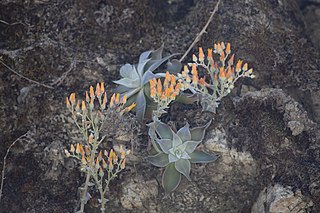
Dudleya cymosasubsp. pumila, most commonly known as the low canyon dudleya, chalky canyon dudleya or California live-forever, is a species of perennial succulent plant. It has diamond to spoon shaped leaves, sometimes coated with a fine white powder, and in May through July, bright red, orange or yellow flowers adorn the short inflorescence. A leaf succulent primarily found growing in rocky cliffs and slopes, it is endemic to California, and grows in the Transverse Ranges and South Coast Ranges, with some outlying populations. A variable plant, in some localities it is difficult to distinguish from other plants in the genus.

Dudleya cymosasubsp. cymosa is a species of succulent perennial plant in the family Crassulaceae native to California. It is the autonymous subspecies for Dudleya cymosa, and is known by the common name canyon liveforever. It is native to the California Coast Ranges, the Sierra Nevada and the Santa Monica Mountains. It is characterized by bright-yellow, orange or red flowers and broad, wide leaves. This plant is commonly found growing on rocky outcrops, talus slopes, and in shaded canyons.
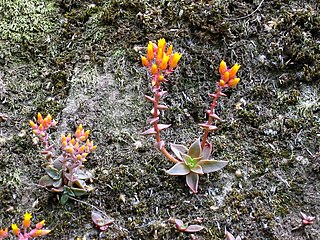
Dudleya cymosa subsp. marcescens is a species of summer-deciduous succulent plant known commonly as the marcescent dudleya or marcescent liveforever. Throughout the months of spring, it is characterized by a bloom of small, bright-yellow flowers with 5 petals, tinged with orange or red. It is a leaf succulent with a basal rosette, with the foliage withering in summer, going completely leafless, a neotenous trait in the genus. This species is endemic to the exposed volcanic rock of the Santa Monica Mountains in California, being found on shady slopes and outcroppings. It differs from its local congeners with its deciduous habit, slender caudex, and narrower leaf shape, although it is superseded in some of these characteristics by Dudleya parva, growing 13 km to the north, which has even narrower leaves and is quicker to lose them. Because of its restricted distribution and small size, it is vulnerable to habitat degradation and disturbance from acts of graffiti and rock climbers. It is listed as threatened by the United States Fish and Wildlife Service.

Dudleya cymosasubsp. agourensis, commonly known as the Agoura Hills dudleya or Agoura Hills liveforever, is a species of perennial succulent plant. A rare and critically imperiled species from the Santa Monica Mountains in California, it is characterized by glaucous, gray-purple leaves, bright yellow flowers, and ascending bracts. A leaf succulent, it is found growing on west to northwest-facing open, rocky volcanic slopes.




















